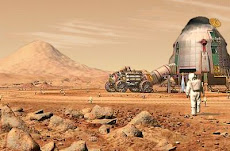Monday, August 6, 2012
Today, the wheels of Curiosity have begun to blaze the trail for human footprints on Mars.
PASADENA, Calif. -- NASA's most advanced Mars rover Curiosity has landed on the Red Planet. The one-ton rover, hanging by ropes from a rocket backpack, touched down onto Mars Sunday to end a 36-week flight and begin a two-year investigation.
The Mars Science Laboratory (MSL) spacecraft that carried Curiosity succeeded in every step of the most complex landing ever attempted on Mars, including the final severing of the bridle cords and flyaway maneuver of the rocket backpack.
"Today, the wheels of Curiosity have begun to blaze the trail for human footprints on Mars. Curiosity, the most sophisticated rover ever built, is now on the surface of the Red Planet, where it will seek to answer age-old questions about whether life ever existed on Mars -- or if the planet can sustain life in the future," said NASA Administrator Charles Bolden.
"This is an amazing achievement, made possible by a team of scientists and engineers from around the world and led by the extraordinary men and women of NASA and our Jet Propulsion Laboratory. President Obama has laid out a bold vision for sending humans to Mars in the mid-2030's, and today's landing marks a significant step toward achieving this goal."
Curiosity landed at 10:32 p.m. Aug. 5, PDT, (1:32 a.m. EDT Aug. 6) near the foot of a mountain three miles tall and 96 miles in diameter inside Gale Crater. During a nearly two-year prime mission, the rover will investigate whether the region ever offered conditions favorable for microbial life.
"The Seven Minutes of Terror has turned into the Seven Minutes of Triumph," said NASA Associate Administrator for Science John Grunsfeld. "My immense joy in the success of this mission is matched only by overwhelming pride I feel for the women and men of the mission's team."
Curiosity returned its first view of Mars, a wide-angle scene of rocky ground near the front of the rover. More images are anticipated in the next several days as the mission blends observations of the landing site with activities to configure the rover for work and check the performance of its instruments and mechanisms.
"Our Curiosity is talking to us from the surface of Mars," said MSL Project Manager Peter Theisinger of NASA's Jet Propulsion Laboratory in Pasadena, Calif. "The landing takes us past the most hazardous moments for this project, and begins a new and exciting mission to pursue its scientific objectives."
Confirmation of Curiosity's successful landing came in communications relayed by NASA's Mars Odyssey orbiter and received by the Canberra, Australia, antenna station of NASA's Deep Space Network.
Curiosity carries 10 science instruments with a total mass 15 times as large as the science payloads on the Mars rovers Spirit and Opportunity. Some of the tools are the first of their kind on Mars, such as a laser-firing instrument for checking elemental composition of rocks from a distance. The rover will use a drill and scoop at the end of its robotic arm to gather soil and powdered samples of rock interiors, then sieve and parcel out these samples into analytical laboratory instruments inside the rover.
To handle this science toolkit, Curiosity is twice as long and five times as heavy as Spirit or Opportunity. The Gale Crater landing site places the rover within driving distance of layers of the crater's interior mountain. Observations from orbit have identified clay and sulfate minerals in the lower layers, indicating a wet history.
The mission is managed by JPL for NASA's Science Mission Directorate in Washington. The rover was designed, developed and assembled at JPL. JPL is a division of the California Institute of Technology in Pasadena.
For more information on the mission, visit: http://www.nasa.gov/marshttp://www.nasa.gov/mars and http://marsprogram.jpl.nasa.gov/mslhttp://marsprogram.jpl.nasa.gov/msl .
Follow the mission on Facebook and Twitter at: http://www.facebook.com/marscuriosity And http://www.twitter.com/marscuriosity .
Guy Webster / D.C. Agle 818-354-6278 / 818-393-9011
Jet Propulsion Laboratory, Pasadena, Calif.
guy.webster@jpl.nasa.gov / agle@jpl.nasa.gov
Dwayne Brown 202-358-1726
NASA Headquarters, Washington
dwayne.c.brown@nasa.gov
Go team USA! Curiosity has landed on Mars!
The United States has a confidence problem. While the economy seems to be slowly improving, many Americans believe our best days are behind us. We are constantly barraged with stories of our inevitable decline - and of the rise of other nations at our expense. Yet the United States can still maintain its position as the leader in technology and innovation, and space exploration capabilities and technology can play a key role.
Carberry is executive director and co-founder of Explore Mars Inc.
When provided with a far-reaching, ambitious mission, NASA is capable of having a much more dramatic impact on our national morale - and, as a result, our economy - than any other federal agency. A bold and sustainable space program has the power to inspire our students to enter into science and engineering studies, create highly skilled jobs that will fuel our economy for years and stimulate the national psyche.
To fully harness this potential, the United States should commit to the goal of landing a crew on Mars by the year 2030. A human mission to the Red Planet would be one of the most important and inspirational events in world history. It would show in no uncertain terms that we again are taking forward-looking, inspired steps in science. The world would take notice. To gauge the impact a Mars landing could have, one need recall only that when Mars Pathfinder landed in 1997, the NASA websites received 550 million hits in a single week - at a time when far fewer people had Internet service.
Imagine the level of online activity that would be wrought by a human Mars mission. The prospects for innovation over the upcoming decades are numerous and would give the United States a chance to take the helm during what could be one of the most exciting periods in human history.
Computer technology, nanotechnology, medical science, biochemistry and many other scientific disciplines are moving at break-neck speed in laboratories, universities, hospitals and companies all across the country. This means commercial companies are competing like never before to help create efficient new space capabilities. But this progress could hit a brick wall if we don't assure the private sector and the public that we have a skilled and well-educated work force capable of keeping this momentum going.
One way to create assurance is to guarantee a sufficient number of American students enter the fields of science, technology, engineering and mathematics (STEM). Space exploration can encourage STEM in a way no other activity can. What we need is a catalyst to motivate our leaders and the nation to commit to ambitious new space goals.
A potential catalyst for change took place this August 6. The Mars Science Laboratory (MSL) called Curiosity landed on Mars. MSL is by far the most ambitious mission to ever be sent to another planet. It should not only send back the most dramatic images ever taken on the surface of Mars, it could move us much closer to learning whether Mars has ever been able to sustain life. The landing also comes close to the 50th anniversary, in September, of President John F. Kennedy's famous "We choose to go to the moon" speech at Rice University.
It is time we recommitted ourselves to courageous and difficult goals. It is time to explore our Solar System and beyound!
To learn more about the Mars Science Laboratory and Curiosity Rover, please visit www.GetCurious.com.
Carberry is executive director and co-founder of Explore Mars Inc.
When provided with a far-reaching, ambitious mission, NASA is capable of having a much more dramatic impact on our national morale - and, as a result, our economy - than any other federal agency. A bold and sustainable space program has the power to inspire our students to enter into science and engineering studies, create highly skilled jobs that will fuel our economy for years and stimulate the national psyche.
To fully harness this potential, the United States should commit to the goal of landing a crew on Mars by the year 2030. A human mission to the Red Planet would be one of the most important and inspirational events in world history. It would show in no uncertain terms that we again are taking forward-looking, inspired steps in science. The world would take notice. To gauge the impact a Mars landing could have, one need recall only that when Mars Pathfinder landed in 1997, the NASA websites received 550 million hits in a single week - at a time when far fewer people had Internet service.
Imagine the level of online activity that would be wrought by a human Mars mission. The prospects for innovation over the upcoming decades are numerous and would give the United States a chance to take the helm during what could be one of the most exciting periods in human history.
Computer technology, nanotechnology, medical science, biochemistry and many other scientific disciplines are moving at break-neck speed in laboratories, universities, hospitals and companies all across the country. This means commercial companies are competing like never before to help create efficient new space capabilities. But this progress could hit a brick wall if we don't assure the private sector and the public that we have a skilled and well-educated work force capable of keeping this momentum going.
One way to create assurance is to guarantee a sufficient number of American students enter the fields of science, technology, engineering and mathematics (STEM). Space exploration can encourage STEM in a way no other activity can. What we need is a catalyst to motivate our leaders and the nation to commit to ambitious new space goals.
A potential catalyst for change took place this August 6. The Mars Science Laboratory (MSL) called Curiosity landed on Mars. MSL is by far the most ambitious mission to ever be sent to another planet. It should not only send back the most dramatic images ever taken on the surface of Mars, it could move us much closer to learning whether Mars has ever been able to sustain life. The landing also comes close to the 50th anniversary, in September, of President John F. Kennedy's famous "We choose to go to the moon" speech at Rice University.
It is time we recommitted ourselves to courageous and difficult goals. It is time to explore our Solar System and beyound!
To learn more about the Mars Science Laboratory and Curiosity Rover, please visit www.GetCurious.com.
Subscribe to:
Posts (Atom)





